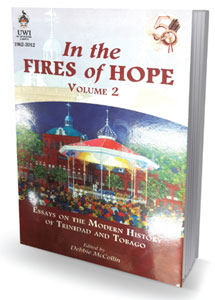
 Book: In the Fires of Hope, Vol. 2: Essays on the Modern History of T&T. Book: In the Fires of Hope, Vol. 2: Essays on the Modern History of T&T.
Author/Editor: Edited by Debbie McCollin
Publishers: ©2016, Ian Randle Publishers & The UWI
Available at: The UWI Bookstore, St Augustine Campus, and Charran’s bookstores.
Review by Allison Ramsay
Allison Ramsay is a lecturer in the Department of History at The UWI
In the Fires of Hope Volume 2: Essays on the Modern History of T&T, edited by Debbie McCollin, offers a narrative of the modern history of T&T from diverse perspectives, on subjects that are not always accorded visibility in Caribbean history.
Published in 2016 by Ian Randle Publishers and The UWI, this comprehensive collection of 20 chapters from established and emerging scholars provides valuable information on the history of T&T from the 19th to the 21st centuries.
The strength of the book lies in its capturing of various experiences, significant periods, specific events and individuals that have shaped the history of T&T. This coverage of social, cultural, political and economic issues that influenced the country’s development offers a balanced presentation of the modern history of the twin-island republic. The writing style and language used by the authors also enhances the readability of the text.
In the Fires of Hope Volume 2 is organized chronologically and topically to take the reader on a historical journey. It is divided into three main sections – the foundations of independence, the expressions of independence, and the challenges of independence – which are further sub-divided.
In the first chapter, Heather Cateau sets the tone with her assertion that “the experiences of colonialism, enslavement and indentureship were, in fact, struggles for independence.”
These experiences reflect the diversity that has shaped the society of T&T. In so doing, contributors such as Cateau bring enslaved seamen to light; Sherry-Ann Singh examines Indian indentured workers beyond the estates and Fiona Rajkumar discusses the socio-economic experiences of the Trinidad Chinese since the Second World War.
Social development relating to education and health are also highlighted. The evolution of teacher education into the 21st century is discussed by Cecilia Hall, Ian Green and Carol Joseph. Meanwhile, McCollin notes some challenges to the decolonization of health care such as “the attack on bush medicine,” and the brain drain of medical personnel.
Protests, whether they are the Water Riot of 1903 as explored by Shane Pantin, or the 1970 Black Power Revolution, affected the society of T&T. Ancil Antoine’s approach provides an enjoyable read of how security and intelligence systems evolved in response to events such as the 1970 revolution and the 1990 coup.
Music, literature and religion are also examined through the writings of Louis Regis, J. Vijay Maharaj and Aakeil Murray, respectively. In relation to masquerade, Gelien Matthews’ analysis of George Bailey, “one of the most celebrated bandleaders in masquerade,” offers insight on Carnival.
The economy is examined from different approaches. Lovell Francis hones in on the 1974 oil boom and economic development, while Sean Ng Wai offers a more grassroots perspective through exploring credit unions.
The political history of T&T is an important subject. Dane Morton-Gittens assesses the administration of Lord Harris’ governance in the 19th century. Bridget Brereton and Michael Toussaint examine an iconic figure, Eric Williams. Brereton focuses on Williams’ construction of an independence narrative. Toussaint uses the diaries of Williams to bring his voice to the fore and to provide revelations about him, his administration and writings.
The political history of Tobago is not excluded. Rita Pemberton gives a constitutional history of Tobago and uses an interesting approach to debate the extent of a possibility of a satisfactory resolution to the constitutional issue.
In the Fires of Hope Volume 2 points out that the history of T&T does not exist in isolation. Regional perspectives and life in the diaspora are just as important to the country’s narrative.
In relation to the diaspora, Eric Duke pays homage to Trinidadian immigrant Charles Petioni, a central activist in Harlem, to the pursuit of “a West Indian nation.” Peter Timothy uses the activities of groups in the United Kingdom and The Republic of Ireland to analyse the promotion of national pride of T&T in these metropolitan spaces.
On a regional note, Dexnell Peters concludes the book with an enjoyable chapter which seeks to “bring the voices of the masses in Trinidad into the record of the Caribbean integration process.” The inclusion of visual images such as cartoons and advertisements and lyrics of calypsos added detail to demonstrating popular perspectives on this issue from Trinidad.
This well-researched volume will be of great interest to students and scholars of 20th and 21st century Caribbean history due to its comprehensive coverage of the modern history of T&T from a myriad of perspectives. It adds to the scholarship on the island and the region. Perhaps, in the near future, a third volume which focuses on the modern history of Tobago, women, gender and cultural developments into the 21st century may become a possibility.
|





